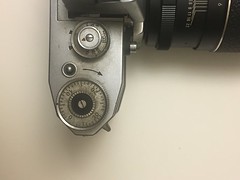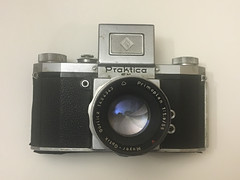Praktica (1949)
The Praktica FX is a relatively early member of the Praktica family, a 35mm SLR introduced by KW in 1952. It accepts M42 lenses, but does not have a mechanism for internally stopping down later lenses such as those made for Pentax SLR's. It is named for its dual flash sync: F (for high speed bulbs) and X (for electronic shutters,) with corresponding PC sockets on the front of the camera.
|
Contents
Physical description
The Praktica is fairly typical of its age in some ways. It is a fairly hefty and angular camera with straightforward design principles. The film advance is by knob, which also doubles as a frame counter, and rewind is also by knob. The shutter is controlled by two dials: one selects a shutter speed, while a smaller, coaxial dial selects either the fast mechanism or the slow mechanism. Each shutter speed requires one mechanism or the other to be engaged to work properly, and two speeds, 1/20 and 1/2, share space on the larger dial. The rim of the larger dial lifts up and turns to select a shutter speed, while the entire dial turns when the shutter is cocked and again when the shutter is released. The shutter release is on the front of the camera body, and has threads for a cable release.
The waist-level finder is shielded by a hood, which pops up at the press of a button. The hood includes a loupe and a sports finder: the loupe folds up to view the focusing screen or to hold the front flap out of the way when the sports finder is in use.
Lenses and optics
The camera can mount and use a very large variety of lenses, including later m42 lenses with pins for automatically stopping down the aperture, though these lenses must have controls to manually stop down the lens for full functionality. It is possible that some m42 lenses protrude too far into the camera, and would possibly damage the mirror or the internal mechanism connected to the mirror. Even putting aside those that would damage the camera, there are an incredible number of lenses available for this camera, from very rudimentary and cheap to highly-sought after fast and sharp lenses of all focal lengths. The camera was usually sold with high quality Zeiss or Meyer Optik lenses.
The viewfinder is bright and sharp, owing to a large condenser lens that sits over the focusing screen (in fact, it seems to be one piece of glass). The loupe is not always necessary to sharply focus the camera, as the image quality even without it is rather high. An auxiliary pentaprism was available: it sat on top of the hood as opposed to replacing it.
Shutter mechanism
The camera has a basic focal plane shutter, which is cocked by advancing the film. It has a top speed of 1/500 and a low speed of 1/2, plus bulb exposure. The mirror is not instant return. The shutter can be cocked without advancing the film by turning the shutter-speed selector until it locks, but this does not lower the mirror. Double exposure is more conveniently achieved as on later SLR's, by pressing the rewind-release button and turning the advance knob.
Flash
The camera has both F sync, which fires slightly before the leading curtain opens, in order to allow an F-type bulb to reach peak output, and X sync, which is for electronic flashes, which reach peak instantly and require no buildup time. There are corresponding PC ports for each sync speed. Flash sync only functions correctly at specific speed (known in later camera parlance as the "x" speed,) which is indicated on the shutter-speed dial with a lightning bolt, not a number, although it is apparently 1/60.
Conclusion
This camera is one of the first full-featured (for the time) SLR's in a line that would become one of the unsung classic SLR families. Building on essentially this base, the M42-mount Praktica went on to be a moderately successful and sometimes innovative series, including cameras that could compete with Pentax, Minolta and Canon in terms of features and available lenses.
The immediate successor, the Praktica F.X 2 would keep the same basic body but make small changes, including a greatly modified viewfinder hood to allow a larger pentaprism accessory and a longer delay for the F-sync. The FX3 would introduce a mechanism for automatically stopping down Pentax-type lenses, but was otherwise much the same as the F.X2. Not until the Praktica IV would the same basic camera receive a large, fixed pentaprism.

|
| Shutter speed dial image by George Parkins (Image rights) |
Technical Specifications
- Type: 35mm SLR
- Manufacturer: Kamera Werkstätten Guthe & Thorsch (better known as "KW.")
- Lens mount: M42 screw mount, no linkage
- Shutter: Focal-plane
- Shutter speeds: 1/2 to 1/500 sec. + B.
- Film Transport: Knob, double exposure prevention.
- Metering: None.
- Exposure: Manual.
- Viewfinder: SLR, waist-level type, auxiliary sport finder.
- Flash: Dual PC sockets for F and X focal plane sync.
External links
- From the Focal Plane to Infinity, page on this camera: [1]

